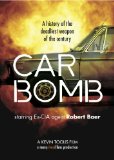“My name is Bob Baer. I used to be a CIA agent stationed in Lebanon during the Civil War. It was chaos. Bu, the real threat was always the car bomb.”
For most of us who are old enough to remember the 1980’s, there are a few moments and events that likely still stick in your mind. Lebanon was the scene for two of the biggest events of that era. Both involved car bombs that shook the world. A marine barracks was bombed on October 23rd, 1983, killing 241 American servicemen. Before that, on April 18th of that same year, another truck bomb destroyed the American Embassy in Lebanon killing 75 people. It was a violent year, with the most United States military deaths ever outside of a war. The weapon of choice in both of these attacks was the car bomb. Ex-CIA agent Bob Baer was there in-country during the attacks. He’s witnessed firsthand what these weapons can do. If anyone can tell us the history of the car bomb, it’s Baer.
“And now we know you can kill a president, defeat a superpower, or just blow up your own government with a car bomb.”
Up until the 9/11 attacks in 2001, the car bomb had been the most effective and frequent weapon of choice for terrorists across the globe. Lebanon is considered the birthplace of the modern car bomb, but the weapon was developed right here in the United States. The first-ever known use of a car bomb was in 1920. An anarchist group bombed Wall Street in retaliation of the infamous Sacco and Vanzetti trials and convictions. That bomb killed 40 and injured over 100 more.
This documentary traces the history of the car bomb. Baer talks to both victims and the bombers themselves. You’ll be impressed with how unrepentant many of these terrorists still are. The feature looks at some of the more prevalent uses of the device. There are segments on the Mafia, the Irish “Troubles”, the first World Trade Center bombing, and of course the Oklahoma City bombing by Timothy McVeigh.
Video
Car Bomb is presented in its original aspect ratio of 1.78:1. This is a documentary with plenty of old archive footage and images. That means the picture is pretty inconsistent because of the nature of the presentation. If you’re watching something like this, it’s not to marvel at the image presentation. It’s as good as the footage will allow.
Audio
The Dolby Digital 2.0 is completely dialog. There are no dynamic sound-design things going on at all. You can hear what Baer and his subjects have to say. That pretty much covers it.
Special Features
Nothing
Final Thoughts:
The film talks about how easy the bombs are to build even in the days before the internet. They are also relatively inexpensive devices. They are incredibly hard to defend against and can do incredible amounts of damage. This feature answers all of those questions you might have. It’s a thorough and interesting exploration of a grisly subject, so there will be images that you should not be watching if you are at all sensitive to such things. There is even graphic footage of 9/11. It’s a sobering presentation. “All you need is roads and traffic. Any airport or government building or street is a target.”





11/22/2010 @ 10:57 pm
Did you know that in 1929, Afghani soldiers went to various countries to train as terrorists? I read it in an article…Italy, England, Russia, France, maybe one more. The article states the Russian trainies didn’t make it. Where are they and what are their names today? Those countries could still support them.
11/22/2010 @ 11:00 pm
They could speak Italian, Russian, French….maybe Spanish..maybe have a job like our by changing their name…immigrants to he U.S, after 1929?…Canada for those who speak French.
11/22/2010 @ 11:03 pm
…I meant a job like yours by changing their name…maybe even serving in the military…you would have to find out who the soldiers were…maybe the Afghanis tell you they don’t understand but do. They probably have nothing else. I am pretty sure it was Afghani soldiers who went to these countries in 1929…could have emmigrated to the US afterwards. Italians were WOPs…”without papers”.